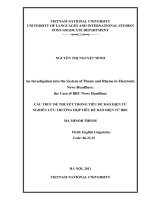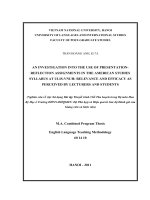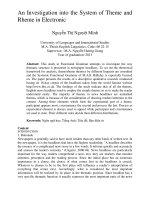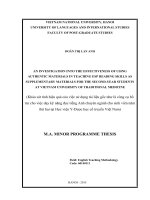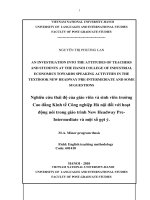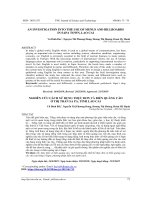An investigation into the participation of high school students in speaking lessons = khảo sát về sự tham gia của học sinh trong giờ học nói tiếng anh tại trường THPT
Bạn đang xem bản rút gọn của tài liệu. Xem và tải ngay bản đầy đủ của tài liệu tại đây (202.57 KB, 54 trang )
An Investigation into the Participation of High School Students in Speaking Lessons
VINH UNIVERSITY
FOREIGN LANGUAGES DEPARTMENT
==========
VÕ THỊ KIM CÚC
AN INVESTIGATION INTO THE PARTICIPATION
OF HIGH SCHOOL STUDENTS IN SPEAKING
LESSONS
(KHẢO SÁT VỀ SỰ THAM GIA CỦA HỌC SINH TRONG GIỜ HỌC
NÓI TIẾNG ANH TẠI TRƯỜNG THPT)
GRADUATION THESIS
FIELD: METHODOLOGY
VINH – 2009
==
Vâ ThÞ Kim Cóc- 46A1 Foreign Languages Department - Vinh University
1
An Investigation into the Participation of High School Students in Speaking Lessons
ACKNOWLEDGEMENTS
For the completion of this thesis, I have been fortunate to receive
invaluable contributions from many people.
First, I especially would like to express my sincere gratitude to my
supervisor, Mrs. Vũ Thị Việt Hương, M.A., who provides me with her
precious knowledge, assistance, consideration and encouragement so that I
can finish this thesis.
I must be grateful to the teachers of Foreign Languages Department,
Vinh University who supply me with good conditions to conduct this
thesis.
My thanks also go to 100 students and 5 Vietnamese teachers of
English at Tran Phu high school for their participation in my survey
questionnaires and semi-structured interviews.
Finally yet importantly, I am greatly indebted to my family and my
friends for their encouragement and support to my process of writing the
thesis.
Vinh, May, 2009
Võ Thị Kim Cúc
Vâ ThÞ Kim Cóc- 46A1 Foreign Languages Department - Vinh University
2
An Investigation into the Participation of High School Students in Speaking Lessons
LIST OF ABBREVIATIONS
A
: Answer
ALM
: Audio Lingual Method
CLT
: Communicative Language Teaching
Etc.
: Et cetera
L
: Lesson
N
: Number
Q
: Question
Ss
: Students
S
: Student
TWC
: Teacher with the whole class
Vâ ThÞ Kim Cóc- 46A1 Foreign Languages Department - Vinh University
3
An Investigation into the Participation of High School Students in Speaking Lessons
LIST OF TABLES
Table 2.1
: Work arrangement used in the speaking lessons
Table 2.2
: Opportunities for the students in class 10A 1 to participate in
five lessons
Table 2.3
: Opportunities for the students in class 10A 3 to participate in
five lessons
Table 2.4
: Frequency of activities in the speaking lessons
Table 2.5
: Results of survey questionnaires
Vâ ThÞ Kim Cóc- 46A1 Foreign Languages Department - Vinh University
4
An Investigation into the Participation of High School Students in Speaking Lessons
TABLE OF CONTENTS
ACKNOWLEDGEMENTS............................................................................
i
LIST OF ABBREVIATIONS.........................................................................
ii
LIST OF TABLES..........................................................................................
iii
TABLE OF CONTENTS................................................................................
iv
PART I: INTRODUCTION...........................................................................
1
1. Rationale of the Study...................................................................................
1
2. Aims of the Study..........................................................................................
2
3. Scope of the Study.........................................................................................
3
4. Methods of the Study....................................................................................
3
5. Design of the Study.......................................................................................
3
PART II: CONTENTS....................................................................................
5
CHAPTER 1: THEORETICAL BACKGROUND......................................
5
Vâ ThÞ Kim Cóc- 46A1 Foreign Languages Department - Vinh University
5
An Investigation into the Participation of High School Students in Speaking Lessons
1.1. Nature of Speaking and Speaking Sub-skills.............................................
5
1.1.1. Nature of Speaking..................................................................................
5
1.1.2. Speaking Sub-skills.................................................................................
6
1.2. Teaching Speaking in Communicative Language Teaching......................
7
1.2.1. Communicative Language Teaching.......................................................
7
1.2.2. Principles of Teaching Speaking in Communicative Language
Teaching............................................................................................................
8
1.2.2.1. Principles for the Beginning Levels.....................................................
9
1.2.2.2. Principles for the Intermediate and Advanced Levels..........................
10
1.3. Speaking Activities....................................................................................
10
1.3.1. Characteristics of a Successful Speaking Activity..................................
10
1.3.2. Problems with Speaking Activities.........................................................
11
1.3.3. Solutions of the Problems with Speaking Activities...............................
12
1.4. Classroom Communicative Tasks..............................................................
13
1.5. Types of Communicative Activities in Speaking Classes..........................
15
Vâ ThÞ Kim Cóc- 46A1 Foreign Languages Department - Vinh University
6
An Investigation into the Participation of High School Students in Speaking Lessons
1.5.1. Oral Drills................................................................................................
16
1.5.2. Information Gap......................................................................................
16
1.5.3. Communication Games...........................................................................
17
1.5.4. Discussions..............................................................................................
18
1.5.5. Questionnaires.........................................................................................
19
1.5.6. Simulation and role-play.........................................................................
20
1.5.7. Problem-solving activities.......................................................................
22
1.5.8. Talking about yourself............................................................................
22
CHAPTER 2: THE STUDY...........................................................................
24
2.1. Research questions.....................................................................................
24
2.2. Research setting..........................................................................................
24
2.3. Description of subjects...............................................................................
24
2.4. Description of data collection instruments.................................................
25
2.4.1. Classroom observations...........................................................................
25
Vâ ThÞ Kim Cóc- 46A1 Foreign Languages Department - Vinh University
7
An Investigation into the Participation of High School Students in Speaking Lessons
2.4.2. Interviews with the teachers....................................................................
26
2.4.3. Survey questionnaires.............................................................................
27
2.5. Procedure....................................................................................................
27
2.6. Preliminary results and data analysis.........................................................
29
2.6.1. Results of classroom observations..........................................................
29
2.6.1.1. Work arrangement used in the speaking lessons..................................
29
2.6.1.2. A fair opportunity for the students.......................................................
29
2.6.1.3. The activities used in the speaking lessons..........................................
32
2.6.2. Results of interviews...............................................................................
33
2.6.3. Results of survey questionnaires.............................................................
35
CHAPTER 3: MAJOR FINDINGS AND DISCUSSIONS........................
38
3.1. Major findings............................................................................................
38
3.1.1. Students' language anxiety and low self-esteem.....................................
38
3.1.2. An unfair opportunity for the students....................................................
39
Vâ ThÞ Kim Cóc- 46A1 Foreign Languages Department - Vinh University
8
An Investigation into the Participation of High School Students in Speaking Lessons
3.1.3. Frequently using guided oral practice activities and the limitation of
communicative activities used in the lessons....................................................
39
3.2. Limitations of the thesis and suggestions for further studies.....................
40
PART III: CONCLUSION.............................................................................
42
REFERENCES
APPENDIX I
APPENDIX II
PART I: INTRODUCTION
1. Rationale of the Study
English has become the language of international trade and transport.
Most planes traveling from one country to another used it to talk with
airports. All ships sailing on the oceans call for help by radio in it. It has
been said that 60 percent of the world’s radio broadcasts and 70 percent of
the world’s mail are in English. An international sport meets, at meeting of
scientists from the corners of the earth, English is the language most
commonly used and most widely understood. English has in fact become
the language of international cooperation in science and technology. The
most advanced results in space, nuclear and computer research are
Vâ ThÞ Kim Cóc- 46A1 Foreign Languages Department - Vinh University
9
An Investigation into the Participation of High School Students in Speaking Lessons
published in it. A scientist who speaks and writes English is in closer touch
with the scientists in other countries than one who does not.
Language is a useful tool for human beings to communicate with one
another. Thus, learning a language means learning how to use language to
communicate successfully. For most people, the ability to speak a language
is synonymous with knowing that language since speech is the most basic
means of human communication. The Communicative Approach teaching
requires developing language learners' four skills: speaking, listening,
reading and writing. However, "speaking in a second or foreign language
has often been viewed as the most demanding of the four skills" (Bailey and
Savage (1994:7)). And Bailey and Savage also suggest that: "speaking is
also an activity requiring the integration of many subsystems…all these
factors continue to make speaking a second or foreign language a
formidable task for language learners…Yet for many people, speaking is
seen as the center skill". For that reason, we would like to carry out this
particular study to help teachers to develop their students' speaking skills.
Certainly that there are many ways to develop learners' speaking
skill, but it is still discussing to choose an appropriate way to teach. Today,
we are trying to teach English in a communicative way followed learnercenter instruction; communicative activities certainly become a necessary
part in language teaching, however, they have not been exploited by the
teachers so far. In addition, although the frequency of different kinds of
work arrangements used affects the participation of the students in speaking
class, the teachers at high school seem not to know how to apply them the
most effectively. Therefore, we found interesting and useful to have a
specific research into the participation of the students in speaking lessons,
we think that we can make use of work arrangement as well as
communicative activities applied in speaking classes because they can
involve students in and make them more active and confident when using
Vâ ThÞ Kim Cóc- 46A1 Foreign Languages Department - Vinh University
10
An Investigation into the Participation of High School Students in Speaking Lessons
English to communicate in class. For this reason, they are useful and
helpful for teachers at high school to teach their students' speaking skill.
For the reasons above, we decided to choose the topic: "An
Investigation into the Participation of High School Students in Speaking
Lessons".
2. Aims of the Study
The Study reported in this thesis aims to:
Investigate the reasons why students are passive and lack of
confidence in speaking English in classroom.
Study different kinds of work arrangements that can be used in a
speaking class.
Make some suggestions for teaching and learning English speaking
skill at high school.
3. Scope of the Study
The Study only covers speaking skill. That does not mean that the
other skills are not concerned about. In fact, the oral ability of the students
is one prominent problem that makes the teachers take into consideration.
Especially, the students' passiveness and their lack of confidence are the
most common factors that contribute to their inability to communicate in
English. It is the fact that the students usually feel embarrassed and nervous
when interacting with other people. Furthermore, they usually keep quite,
take a passive role or speak so softly that no one can hear in oral practice.
Therefore, this Study only focuses on identifying the causes of the abovementioned problems.
4. Methods of the Study
Vâ ThÞ Kim Cóc- 46A1 Foreign Languages Department - Vinh University
11
An Investigation into the Participation of High School Students in Speaking Lessons
There are varieties of measures that are available for the research.
However, in the narrow scope of the Study, we only use some of them.
They are:
Descriptive method
Qualitative method
Quantitative method
Analysis method
5. Design of the Study
Except for the acknowledgements and the table of contents, the
Study consists of three main parts, a list of references and appendices.
Part I: Introduction
The Introduction deals with the rationale, aims, methods, scope and
design of the Study.
Part II: Contents
This part consists of three chapters. Chapter 1 deals with theoretical
background that includes nature of speaking and speaking sub-skills,
teaching speaking in communicative language teaching, speaking activities,
classroom communicative tasks and types of communicative activities in
speaking classes. Chapter 2, the study, presents the methodology adopted to
collect data for the research. It contains research questions of the study,
research setting, description of subjects, descriptions of data collection
instruments, procedure and preliminary results and data analysis. Chapter 3
describes the major findings and discussions.
Part III: Conclusion
This is the final part of the thesis. It summarizes what have been
presented in the thesis.
Vâ ThÞ Kim Cóc- 46A1 Foreign Languages Department - Vinh University
12
An Investigation into the Participation of High School Students in Speaking Lessons
The study ends up with “References”, with a list of sources of
materials and “Appendices”, with the questionnaires of the survey.
PART II: CONTENTS
CHAPTER 1: THEORETICAL BACKGROUND
1.1. Nature of Speaking and Speaking Sub-skills
1.1.1. Nature of Speaking
Speaking is one of the features that distinguishes us from most, if not
all, animals because it is the common way to convey ideas from one person
to another through language. Language is a complicated phenomenon and
language learning is a complicated process, so speaking a foreign language
is a complex skill.
Vâ ThÞ Kim Cóc- 46A1 Foreign Languages Department - Vinh University
13
An Investigation into the Participation of High School Students in Speaking Lessons
Of all the four skills, the speaking seems intuitively the most
important. Ur (1996:56) states people who know a language are referred to
as: "speakers of that language as if speaking included all other kinds of
knowing and many if not most foreign language learners are primarily
interested in learning to speak".
Speaking involves language production and is therefore often
referred to as productive skills. Moreover, according to Byrne (1976:8)
says that "speaking is a two-way process between speaker(s) and listener(s)
involving the productive skills of understanding". Byrne (1995:10) gives the
following diagram to show what happens in a speech situation and
incidentally, therefore, what is involved in oral ability:
Initiate
Speak
Oral ability
Respond
Listen
In some situations, one person may do all the speaking, so the
speaker initiates and simply keeps up the flow of speech, for example
giving a lecture, instructions or directions. Normally, however, as in a
conversation although one person initiates, the speaker and the listener are
constantly changing the roles and consequently speaking involves
responding to what has been regarded. In this case, speaking is an integral
part of listening. So speaking belongs to integrated skills.
1.1.2. Speaking Sub-skills
In order to use language skills, competent use of a language need a
number of sub-skills. Bygate (1987:6) suggests that speaking consists of
four sub-skills that are:
Motor-perceptive skill
Vâ ThÞ Kim Cóc- 46A1 Foreign Languages Department - Vinh University
14
An Investigation into the Participation of High School Students in Speaking Lessons
Interaction skill
Compensatory strategies
Production skill
Motor-perceptive skill concerns grammatical competence because it
implies mastery of vocabulary, grammar, pronunciation and structure of
sentences. This is regarded as a fundamental factor. Interaction skill refers
to general knowledge of the interaction, which relates to social-linguistic
competence. Bygate (1987:7) claims that: "Interaction skills include using
knowledge and the basic motor perceptive skills to achieve communication
and they involve making decision about communication". Compensatory
strategies are concerned with strategic competence and the skill to produce
what speakers want to say with considering discourse is called production
skill in speaking.
The four sub-skills above have a very close and subsidiary
relationship, which makes up the complete speaking skill. Lewis and Hill
(1992) also indicate that language skills, both receptive and productive,
need to be broken into sub-skills and teaching needs to build from small
units to larger, not leap from a detail to the whole.
1.2. Teaching Speaking in Communicative Language Teaching
1.2.1. Communicative Language Teaching
Communicative Language Teaching (CLT) is an approach to the
teaching of second and foreign languages that emphasizes interaction as
both the means and the ultimate goal of learning a language. It is also
referred to as “communicative approach to the teaching of foreign
languages” or simply the “Communicative Approach”.
As an extension of the notional-functional syllabus, CLT also places
great emphasis on helping students use the target language in a variety of
contexts and places great emphasis on learning language functions. Unlike
Vâ ThÞ Kim Cóc- 46A1 Foreign Languages Department - Vinh University
15
An Investigation into the Participation of High School Students in Speaking Lessons
the Audio Lingual Method (ALM), its primary focus is on helping learners
create meaning rather than helping them develop perfectly grammatical
structures or acquire native-like pronunciation. This means that
successfully learning a foreign language is assessed in terms of how well
learners have developed their communicative competence, which can
loosely be defined as their ability to apply knowledge of both formal and
sociolinguistic aspects of a language with adequate proficiency to
communicate.
CLT is usually characterized as a broad approach to teaching, rather
than as a teaching method with a clearly defined set of classroom practices.
As such, it is most often defined as a list of general principles or features.
One of the most recognized of these lists is David Nunan’s (1991) five
features of CLT:
1. An emphasis on learning to communicate through interaction in
the target language.
2. The introduction of authentic texts into the learning situation.
3. The provision of opportunities for learners to focus, not only on
language but also on the Learning Management process.
4. An enhancement of the learner’s own personal experiences as
important contributing elements to classroom learning.
5. An attempt to link classroom language learning with language
activities outside the classroom.
These five features are claimed by practitioners of CLT to show that
they are very interested in the needs and desires of their learners as well as
the connection between the language as it is taught in their class and as it
used outside the classroom. Under this broad umbrella definition, any
teaching practice that helps students develop their communicative
competence in an authentic context is deemed an acceptable and beneficial
form of instruction. Thus, in the classroom CLT often takes the form of
Vâ ThÞ Kim Cóc- 46A1 Foreign Languages Department - Vinh University
16
An Investigation into the Participation of High School Students in Speaking Lessons
pair and group work requiring negotiation and cooperation between
learners, fluency-based activities that encourage learners to develop their
confidence, role-plays in which students practice and develop language
functions, as well as judicious use of grammar and pronunciation focused
activities.
1.2.2. Principles of Teaching Speaking in Communicative Language
Teaching
It is important to remember that the goal in language use is natural
communication in which real information is transferred through speech.
According to Forseth, et.al. (1996:35) divide the principles into two groups:
principle for the beginning levels and the ones for the immediate and
advanced levels.
1.2.2.1. Principles for the Beginning Levels
First of all, the teacher should limit the objectives to avoid making
students confused. It means that the teacher should provide the students
with enough structured practice so they can begin interacting at a basic
level. This will reduce students’ fear and encourage more speaking. Later,
more free production can come after structured practice.
Secondly, the teacher should mix the speaking activities with
comprehension work. The teacher should have students listen to the teacher
or each other before they speak. When students listen before they speak, it
leads to speech that is more natural. Also, comprehension work fosters an
interaction between speaking and listening.
The third principle is that the teacher should provide activities that
involve dialogue and functional use of the language. Language use should
Vâ ThÞ Kim Cóc- 46A1 Foreign Languages Department - Vinh University
17
An Investigation into the Participation of High School Students in Speaking Lessons
be focused on rather than knowledge about language. Functions involve a
focus of meaning. Dialogues are more concrete and controlled than less
structured drills.
Another principle is that the teacher should not emphasize the
significance of mistakes because this encourages students to speak without
fear of correction and this increases the focus on meaning and
communication rather than grammatical correctness. The correction should
especially focus on problems affecting clear communication or language
already taught to the students.
One more principle is to state the purpose or goal of the activity to
the students that provide a context or focus to help comprehension and
allows the learners to concentrate on the task and understand why they
doing it.
1.2.2.2. Principles for the Intermediate and Advanced Levels
The first principle is to focus on and work toward real, spontaneous
speech. The teacher should avoid giving students form-based drills
(repetitious or grammar-based exercises) and should remember real speech
is most often unrehearsed and practiced in order to reach that kind of
speech.
The second principle is to design activities that encourage natural
interaction between speakers. Human speech most often involves
interaction which integrates speaking and listening.
Next, the teacher should place students in pairs, triads or small
groups. Smaller groups, triads and pairs are student-centered. This
increases the quantity of speech spoken by the students and relieves their
anxiety.
Vâ ThÞ Kim Cóc- 46A1 Foreign Languages Department - Vinh University
18
An Investigation into the Participation of High School Students in Speaking Lessons
Then, the teacher also should provide topics of interest to the
students. This fosters a focus on meaning and interesting topics increase
student motivation. Yet, it is good to ask students what they are most
interested in.
The last principle is that at the advanced level, especially in free
production, the teacher should allow only speech in the target language.
This greatly increases the amount of English spoken. Students may dislike
this but should be discouraged from using their own language without the
teacher’s permission.
1.3. Speaking Activities
1.3.1. Characteristics of a Successful Speaking Activity
Classroom activities that develop learner's ability to express
themselves through speech would therefore seem an important component
of a language course. Successful speaking activities in class can result in
great improvement of students' speaking skills. The teacher should try to
design and administer such activities. As is discussed in Ur (1996:120),
they have four characteristics
Firstly, students talk a lot. As much as possible of the period of time
allotted to the activity is in fact occupied by student talk. This may seem
obvious, but often most time is taken up with teacher talk or pauses.
Secondly, participation is even. Classroom discussion is not
dominated by a minority of talkative participants; all get a chance to speak,
and contributions are fairly evenly distributed.
Thirdly, motivation is high. Students are eager to speak because they
are interested in the topic and have something new to say about it, or
because they want to contribute to achieving a task objective.
Vâ ThÞ Kim Cóc- 46A1 Foreign Languages Department - Vinh University
19
An Investigation into the Participation of High School Students in Speaking Lessons
Finally, language is of an acceptable level. Students express
themselves in utterances that are relevant, easily comprehensible to each
other, and of an acceptable level of language accuracy.
In conclusion, if we want to have successful speaking activity or if
we want to get students talking, we need to meet all these above criteria.
1.3.2. Problems with Speaking Activities
In spite of knowing the criteria to reach a successful speaking
activity, the teacher often encounters many problems in getting students to
talk in the classroom. Ur (1996:121) discusses some following common
problems
Inhibition is one of the problems with speaking activities. Unlike
reading, writing and listening activities, speaking requires some degree of
real-time exposure to an audience. Students are often inhibited about trying
to say things in a foreign language in the classroom: worried about making
mistakes, fearful of criticism or losing face, or simply shy of the attention
that their speech attracts.
Furthermore, students have nothing to say. Even if they are not
inhibited, you often hear learners complain that they can not think of any
thing to say: they have no motive to express themselves beyond the guilty
feeling that they should be speaking.
One more problem is low or uneven participation. Only one
participant can talk at a time if he or she is to be heard; and in a large
group, this means that each one will have only very little talking time. This
problem is compounded by the tendency of some learners to dominate
while others speak very little or not at all.
Mother tongue use is also a problem happening in speaking class. In
classes, where all, or a number of, the learners share the same mother
tongue, they may end to use it because it is easier; and they feel less
Vâ ThÞ Kim Cóc- 46A1 Foreign Languages Department - Vinh University
20
An Investigation into the Participation of High School Students in Speaking Lessons
"exposed" if they are speaking their mother tongue. If they are talking in
small groups, it can be quite difficult to get some classes; particularly the
less disciplined or motivated ones-to keep to the target language.
1.3.3. Solutions of the Problems with Speaking Activities
Ur (1996:121) provides some suggested solutions to the problems
above. The first solution is using group work. This increases the sheer
amount of student talk going on in a limited period of time and also lowers
the inhibitions of the students who are unwilling to speak in front of the full
class. It is true that group work means the teacher can not supervise all
student speech, so that not all utterances will be correct, and students may
occasionally slip into their native language; nevertheless, even taking into
consideration occasional mistakes and mother tongue use, the amount of
time remaining for positive, useful oral practice is still likely to be far more
than in the full-class set-up.
Next, the second suggested solution is basing the activity on easy
language. In general, the level of language needed for a discussion should
be lower than that used in intensive language-learning activities in the same
class: it should be easily recalled and produced by the participants, so that
they can speak fluently with the minimum of hesitation. It is a good idea to
teach or review essential vocabulary before the activity starts.
Moreover, the teacher should make a careful choice and task to
stimulate interest. On the whole, the clearer the purpose of the discussion is
the more motivated participants will be.
Another solution is giving some instruction or training in discussion
skills. If the task is based on group discussion, then include instructions
about participation when introducing it. For example, tell learners to make
sure that everyone in the group contributes to the discussion; appoint a
chairperson to each group who will regulate participation.
Vâ ThÞ Kim Cóc- 46A1 Foreign Languages Department - Vinh University
21
An Investigation into the Participation of High School Students in Speaking Lessons
Finally yet importantly, the teacher should keep students speaking
the target language. You might appoint one of the group members as
monitor, whose job is to remind participants to use the target language, and
perhaps report later to the teacher how well the group managed to keep to
it. Even if there is no actual penalty attached, the very awareness that
someone is monitoring such lapses helps participants to be more careful.
However, when all is said and done, the best way to keep students
speaking the target language is simply to be there yourself as much as
possible, reminding them and modeling the language use yourself: there is
no substitute for nagging.
1.4. Classroom Communicative Tasks
Nunan (1989) argues that the concept of the communicative task can
provide a way of integrating the research on language learning and use as
well as give practical effect to the research at the level of pedagogical
action. It is described as:
"A piece of classroom work which involves learners in comprehending,
manipulating, producing and interacting in the target language while their
attention is principally focused on meaning rather than form. The task
should also have a sense of completeness, being able to stand alone as a
communicative act in its own right".
(Nunan (1989:10)).
Hedge (2000:61) sees communicative tasks as an "essential
ingredient in a program but as part of a balance diet of accuracy and
fluency work". It means a series of tasks can usefully provide the basic of a
program, in which case their selection, organization and sequencing will
need to create opportunities for a focus on accuracy and input into the
interlanguage system as well as fluency.
Vâ ThÞ Kim Cóc- 46A1 Foreign Languages Department - Vinh University
22
An Investigation into the Participation of High School Students in Speaking Lessons
Harmer (1991:49) indicates two types of speaking tasks: one-way
information gap tasks in which the speaker has all the information, which
must be conveyed to the listener, and two-way information gap tasks in
which both participants must pool their information in order to complete
the task successfully.
Littlewood (1982:86) presents typical classroom activities used to
teach speaking on the following diagram:
Structural activities
Pre-communicative activities
Quasi-communicative activities
Functional communicative activities
Communicative activities
Social interaction activities
The diagram suggests a teaching procedure. Littlewood divides the
stages of learning into pre-communicative activities and communicative
activities. The pre-communicative activities train students in the language
forms through practice in which they learn to relate language form to their
potential functional meanings and communicative activities give them
opportunities to use language as effectively as they can with resources
available, if their language is socially appropriate. In other words, precommunicative activities emphasize grammatical accuracy (the cognitive
aspect) and communicative activities emphasize social acceptability
(behavioral aspect of language). The two major categories are each subdivided. Under pre-communicative activities, there are structural activities
(similar to introducing new language) and quasi-communicative activities
Vâ ThÞ Kim Cóc- 46A1 Foreign Languages Department - Vinh University
23
An Investigation into the Participation of High School Students in Speaking Lessons
(similar to the practice stage). Structural activities consist of structural
exercises, focusing on grammatical system and on the ways in which
linguistic items can be combined. Quasi-communicative activities that
consist of one or more typical conversation exchanges are intended to help
students relate forms and structures to three typical kinds of sentence
meanings: communicative function, specific meaning, and social context.
The second major type of activities, communicative one is also of two
kinds: functional communication activities and social interaction activities.
In the case of functional communication activities, the main purpose is that
students should use the language they know in order to get meanings across
as effectively as possible. Social interaction activities, on the other hand,
involve exploiting simulation and role-playing.
1.5. Types of Communicative Activities used in Speaking Class
Speaking has different aspects. They are accuracy and fluency.
Accuracy involves the correct use of vocabulary, grammar and
pronunciation. According to Bailey and Savage (1994:34), fluency can be
thought of as: "the ability to keep going when speaking spontaneously".
With the natural of spoken language which has been pointed above, the
main goal in speaking and learning speaking skills will be oral fluency:
"the main ability to express oneself intelligibly, accurately and without too
much hesitation" (Byrne (1986:9)). Several checklists of fluency activities
have been published. For example, Klippel (1988) offers interview,
guessing games, jigsaw tasks, questioning activities, ranking exercises,
discussion games, values classification techniques, thinking strategies,
problem-solving activities, role-play and simulation. Harmer (1991) and
Littlewood (1982) provide similar lists but all of these are categorized in
different ways.
Vâ ThÞ Kim Cóc- 46A1 Foreign Languages Department - Vinh University
24
An Investigation into the Participation of High School Students in Speaking Lessons
1.5.1. Oral Drills
Drills are widely used for accuracy practice of new items. Oral
accuracy practice involves the repetition of a language pattern or patterns.
Repetition in accuracy practice is based on the principle substitution in a
pattern. Drill work is very useful because it provides opportunities for
students to practice a new bit of language in the most controlled way. In
other words, drill gives students the opportunity for safe practice; accuracy
can be focused on as the students get a chance to rehearse language. Most
drills can be adapted for pair work and group work. However, they are
usually controlled and therefore, they have limited potential. Because they
are repetitive and not very creative, they should not be used for too long or
too frequently.
1.5.2. Information Gap
The term "Information Gap" is mentioned by Wright, Betteridge and
Bucky (1990:24). This term is widely used to describe features essential to
communication in our daily life as Harmer (1983:95) states that
"Information gap is an ingredient in most real life communication". With
information gap activities, different students are given different parts
information making up a whole. Normally, there is worksheet A and B of
everything. Students will work in pairs; one will look at worksheet A while
the other will look at worksheet B. Because they have different
information, there is a "gap" between them and in order to complete the
task, they must share the information they have with each other by using
English. Communicative accuracy practice requires some forms of
information gap. Information gap can be designed to provoke the practice
of more or less specific items of language. In fact, it is not easy to organize
it, the teacher may lose control of the class since the students are so curious
that they want to look at each other's paper before completing the task.
Vâ ThÞ Kim Cóc- 46A1 Foreign Languages Department - Vinh University
25

